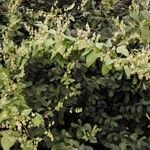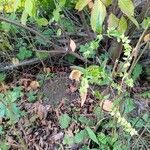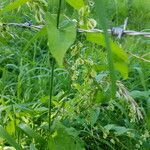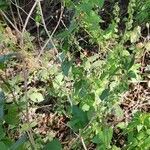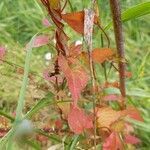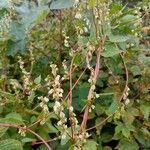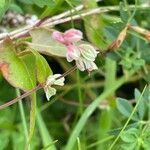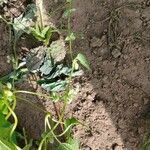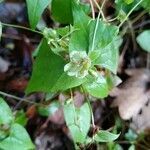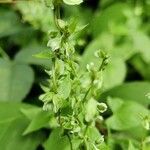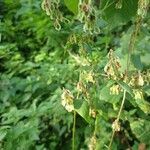Herbs, annual, not rhizomatous, to 3 m. Stems scandent or climbing, rarely prostrate, freely branched, herbaceous, glabrous to papillose or scabrid, not glaucous. Leaves: ocrea usually deciduous, tan or brown, cylindric to funnelform, 1.5-3.5 mm, margins oblique, face not fringed with reflexed hairs and slender bristles at base, otherwise glabrous or scabrid; petiole 0.3-2.5 cm, glabrous or scabrid in lines; blade triangular to hastate, 2-8 × 1-5 cm, base cordate to truncate, margins wavy, scabrid, apex acute to acuminate, abaxially and adaxially faces glabrous or papillose to scabrid, not glaucous, the abaxial rarely minutely dotted. Inflorescences axillary, erect or spreading, racemelike, 2-20 cm, axes glabrous or scabrid; peduncle 0.1-6 cm or absent, glabrous or scabrid. Pedicels ascending or spreading to deflexed, articulated distally, 4-8 mm, glabrous. Flowers bisexual, 2-6 per ocreate fascicle; perianth accrescent in fruit, greenish white or pinkish, 3.5-7 mm including stipelike base, glabrous; tepals elliptic to obovate, apex obtuse to acute, outer 3 winged; stamens 8; filaments flattened proximally, pubescent proximally; styles connate; stigmas capitate. Achenes included, black, 2-4 × 1.8-2.4 mm, shiny, smooth; fruiting perianth glabrous, wings flat or, less often, undulate or crinkled, 1.5-2 mm wide, usually truncate or attenuate-decurrent on stipelike base nearly to articulation, margins entire or rarely undulate-crenate. 2n = 20.
More
Herbs annual. Stems twining, 70-150 cm, striate, papillate, glabrous, much branched. Petiole 1-3 cm, papillate; leaf blade ovate-cordate, 3-6 × 1.5-4 cm, both surfaces glabrous, along veins minutely papillate, base cordate or sagittate, margin entire, apex acuminate; ocrea short, 2-3 mm, membranous, oblique, apex acute, not ciliate. Inflorescence usually axillary, racemose, lax, few or many flowered; bracts 1.5-2 mm, membranous, each 1-6-flowered. Pedicel 3-4 mm, slender, articulate, elongate in fruit. Perianth greenish, 5-parted; tepals elliptic, 2-3 mm, unequal in size, outer 3 larger and winged in fruit; wings entire, slightly decurrent along pedicels. Perianth (including wings) in fruit orbicular, 4-4.5 mm in diam. Stamens 8, included. Styles very short; stigmas capitate. Achenes included in persistent perianth, black, shiny, ellipsoid, trigonous, 3-3.5 mm, smooth. Fl. Jun-Aug, fr. Jul-Sep.
A climbing herb. It can grow to 2 m long. It is twining and the stems are branched. It grows each year from seed. The leaves are simple and may have lobes. They are 3-8 cm long by 2-5 cm wide. The fruit are 2-4 mm long and dry.
Hedges and thickets. Grassy slopes, thickets and mixed forests in valleys, mountain valleys, fields; at elevations from 200-2,400 metres.
More
It is a temperate plant. In Pakistan it grows between 1,800-4,500 m above sea level. It grows near rivers and lakes in wetlands.

